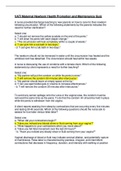Samenvatting
Samenvatting Applying Social Psychology (3e editie)
- Instelling
- Universiteit Utrecht (UU)
Uitgebreide samenvatting van het boek 'Applying Social Psychology: From Problems to Solutions (3e editie)' met EAN 2016. Boek voor de cursus From Theory to Intervention (SHOP master). Bevat alle hoofdstukken uit het boek, inclusief afbeeldingen. Comprehensive summary of the book 'Applying Soc...
[Meer zien]







